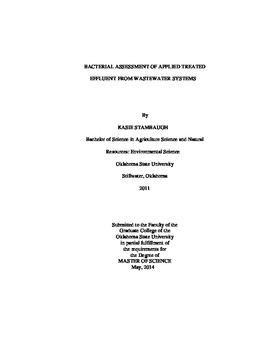| dc.contributor.advisor | Fox, Garey A. | |
| dc.contributor.author | Stambaugh, Kasie | |
| dc.date.accessioned | 2015-06-17T20:08:08Z | |
| dc.date.available | 2015-06-17T20:08:08Z | |
| dc.date.issued | 2014-05-01 | |
| dc.identifier.uri | https://hdl.handle.net/11244/15134 | |
| dc.description.abstract | Aerobic Treatment Systems (ATS) are a form of water reuse, practiced by citizens in the United States and in Oklahoma. ATS collect water, including wastewater, leaving home(s) and discharge the treated wastewater on the soil surface. ATS treat wastewater effluent through processes of aeration; some ATS use methods of nitrogen reduction and chlorination disinfection. In Oklahoma, ATS are regulated for two years, post installation by a certified technician. Concerns for human health and the safety of the environment are associated with land-applied effluent from ATS relative to possible Escherichia coli (E. coli) and fecal coliform bacteria concentrations; treatment processes in Oklahoma need to be investigated to quantify bacteria concentrations in effluent. Phase one of this study quantified bacteria concentrations from the holding (pump) tanks of ATS relative to the environmental condition under which they were stored. E. coli populations did not completely die off until week four of the study indicating survival of the bacteria for long-periods in holding tanks. Phase one also showed fecal coliform testing results contained levels of fecal coliforms exceeding 200 MPN/100 mL sample; fecal coliform concentrations thrived under certain environmental conditions, increasing concerns about the presence of bacterium. Phase two of this study quantitated bacteria concentrations in the soil after applying the effluent from the pre-treatment tanks of ATS. E. coli concentrations dropped to less than 200 MPN/g (under all stored conditions) at 48 hours. Exceeding levels of fecal coliforms were detected throughout the study (phase two); under certain environmental conditions fecal coliforms thrived in the soil and did not die off. The overall findings from phase one and phase two of this research lead to an ATS assessment of rules and regulations in Oklahoma pertaining to E. coli and fecal coliform bacterium concentrations. Enforcement standards in Oklahoma are lacking in regulating ATS, especially in regards to established bacteria standards. Enhanced levels of regulations were recommended and a fact sheet was created to inform the public of associated concerns. ATS discharge exceeding levels of bacteria under variable conditions. | |
| dc.format | application/pdf | |
| dc.language | en_US | |
| dc.publisher | Oklahoma State University | |
| dc.rights | Copyright is held by the author who has granted the Oklahoma State University Library the non-exclusive right to share this material in its institutional repository. Contact Digital Library Services at lib-dls@okstate.edu or 405-744-9161 for the permission policy on the use, reproduction or distribution of this material. | |
| dc.title | Bacterial Assessment of Applied Treated Effluent from Wastewater Systems | |
| dc.type | text | |
| dc.contributor.committeeMember | Boyer, Tracy A. | |
| dc.contributor.committeeMember | Ferrell, Shannon L. | |
| osu.filename | Stambaugh_okstate_0664M_13387.pdf | |
| osu.accesstype | Open Access | |
| dc.description.department | Environmental Sciences | |
| dc.type.genre | Thesis | |
| dc.subject.keywords | aerobic | |
| dc.subject.keywords | bacteria | |
| dc.subject.keywords | coliform | |
| dc.subject.keywords | concerns | |
| dc.subject.keywords | escherichia coli | |
| dc.subject.keywords | treatment | |
